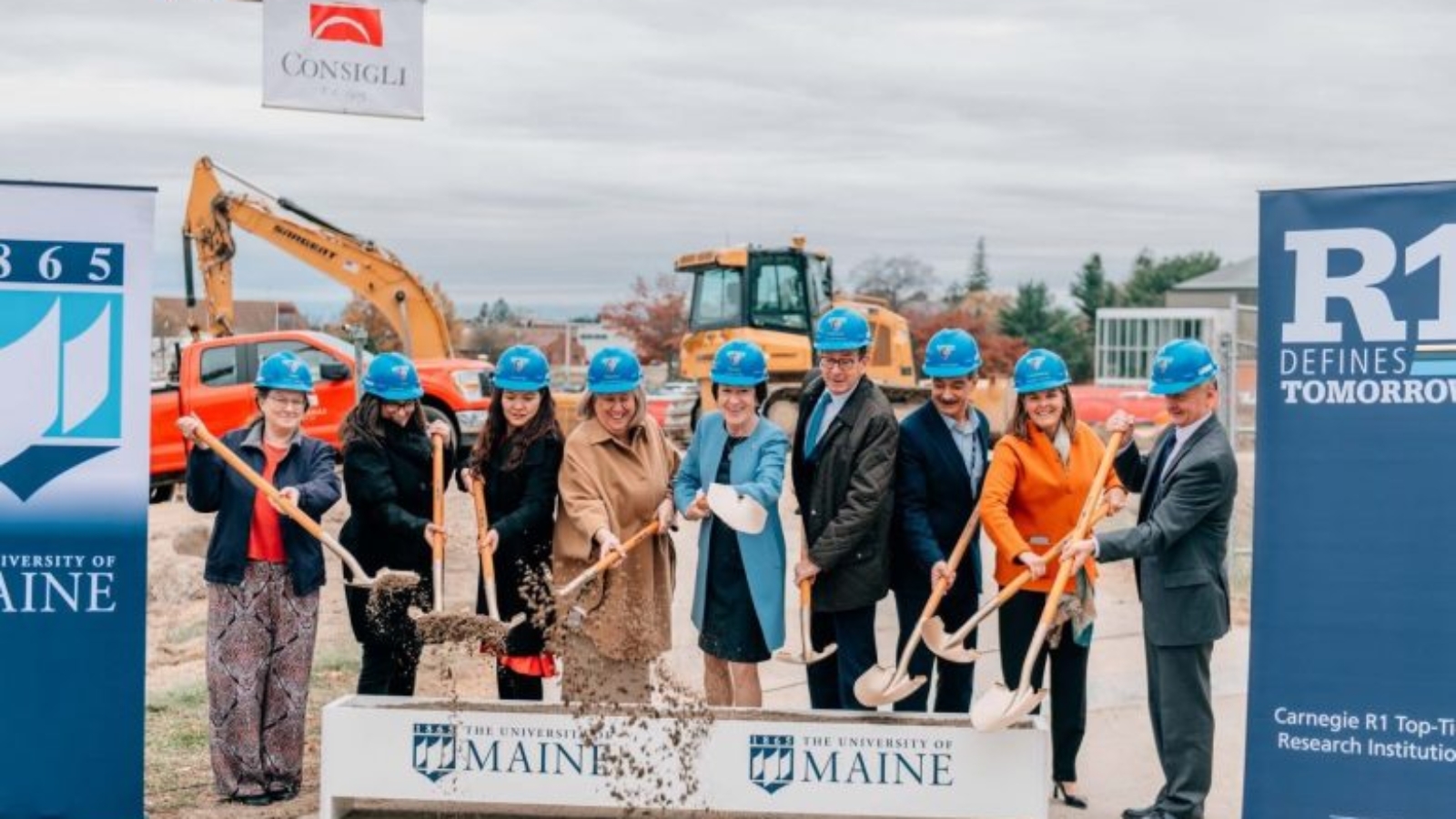According to the University of Maine, ground has been broken on the Green Engineering and Materials (GEM) building, a 50,000-square-foot facility designed to house the cutting-edge Factory of the Future (FoF) – incorporating digital manufacturing technologies and fully adaptive, immersive learning spaces for students at UMaine and across the University of Maine System.
Scheduled for completion in 2026, GEM represents a nearly $82 million investment in interdisciplinary research and innovative education. This facility has been designed to meet the research and education needs in advanced manufacturing, as well as to train the engineering and computing workforce, which is essential to support and grow the state and nation’s economies. GEM will operate as a partnership between the Advanced Structures and Composites Center (ASCC), the Maine College of Engineering and Computing (MCEC), and the College of Liberal Arts and Sciences (CLAS), with opportunities for other programs and industries on campus and remotely.
“This project started as an ambitious vision, and it is becoming a reality thanks to interdisciplinary collaboration and a vision that integrates research and learning,” said Joan Ferrini-Mundy, President of UMaine and its regional campus, the University of Maine at Machias. “We are grateful for all who have made this investment in this public university research facility. As a national research institution with R1 Carnegie classification, UMaine has the talent and reputation for innovation and achievement. Once completed, GEM will create even greater opportunities for our students, faculty, staff, and partners to address a multitude of economic and societal needs for Maine and beyond.”
GEM will also serve as a large-scale digital additive and hybrid manufacturing test bed for entrepreneurs and companies looking to integrate advanced manufacturing and sustainable technologies into their operations. With a focus on bio-based materials and sustainable technologies, GEM aims to leverage Maine’s competitive strengths and drive investment in sustainable manufacturing.
GEM will work with industry to manufacture affordable housing, marine vessel production, and renewable energy and civil infrastructure components, all while using bio-based materials.
GEM’s role is to conduct advanced manufacturing research and workforce development training so that these new technologies can be transitioned to industry. Students at all levels, from visiting K-12 students to doctoral candidates, will experience the innovative FoF environment through interactive, distributed, and connected learning spaces.
GEM will allow students to move from interactive classroom spaces with UMaine System-wide access; to immersive learning within the mini-GEM, a microcosm of the full laboratory; up to working within the two large manufacturing bays, researching how best to design and manufacture homes, boats, and other products.
Manufacturing on Demand
“The GEM FoF will usher in a new era of digital manufacturing, using renewable materials, at the nexus of engineering and computing. This immersive education and research facility takes the next step in large-scale flexible additive and hybrid manufacturing with the goal to produce large, integrated systems in a closed-loop digital manufacturing environment powered by high-performance computing and artificial intelligence,” said Habib Dagher, Executive Director of ASCC.
“GEM is a cornerstone of the strategic vision at the University of Maine which, in collaboration with all campuses across the University of Maine System, emphasizes experiential learning, research, and teaching integration. It is an important example of how research centers and colleges will collaborate to transform education,” said Giovanna Guidoboni, Dean of the Maine College of Engineering and Computing. “Often, academic buildings host classrooms and research laboratories that enable small-scale prototyping. In this transformative building, students can take the leap from ideating a proof of concept to manufacturing a large-scale market-ready product. This leap seems enormous; yet, this is what is needed to grow our economy. Here, we make this possible.”
“By providing transformative learning experiences that blend theory with practice, we prepare our students to tackle real-world challenges, aligning with our goal of producing highly skilled graduates who are ready to lead in their fields”, said Emily Haddad, Dean of CLAS. “GEM’s learning spaces are designed to promote interaction, both in person and at a distance, and they will facilitate students’ transition to experiential learning environments.”
“Maine has the leading role in hybrid and additive manufacturing to produce large-scale products driven by new technology in industries such as clean technologies, boat building, and transportation technologies,” said US Senator Susan Collins. “A treasure of new products, new opportunities, and a new future lay in store with GEM.”
“The Harold Alfond Foundation has always believed that education is key to a skilled workforce,” said Greg Powell, Chair of the Harold Alfond Foundation. “But it’s more than that. The skilled workforce that we have has to be a workforce for tomorrow and has to be energized and inspired by the things that we do. Life has to be more than a job, it has to be inspirational, and one of the key attributes of GEM is how inspirational it is and how it will inspire students of today with the possibilities of the future.”
GEM is supported by several funding sources, including the Harold Alfond Foundation through UMS TRANSFORMS, UMaine, UMS, the US Department of Defense, the Maine Jobs & Recovery Act, the National Institute of Standards and Technology, the State of Maine, and the Northern Border Regional Commission’s Catalyst Program.
You might also like:
StEnSea energy storage project receives $7.7M from US and Germany: The StEnSea project has been in development since 2012 and was conceived by researchers at the Fraunhofer Institute, who were interested in significantly increasing the duration of energy storage by leveraging principles of pumped storage hydropower for subsea environments. The idea behind the project is to submerge hollow spherical concrete structures, which will sink to the seabed and fill with water. These spheres will remain at a depth of 600 to 800 meters and when electricity demand is low, they will be emptied of water using submersible pumps to store potential energy.
* This article is reprinted from 3D Printing Media Network. If you are involved in infringement, please contact us to delete it.
Author: Edward Wakefield



Leave A Comment